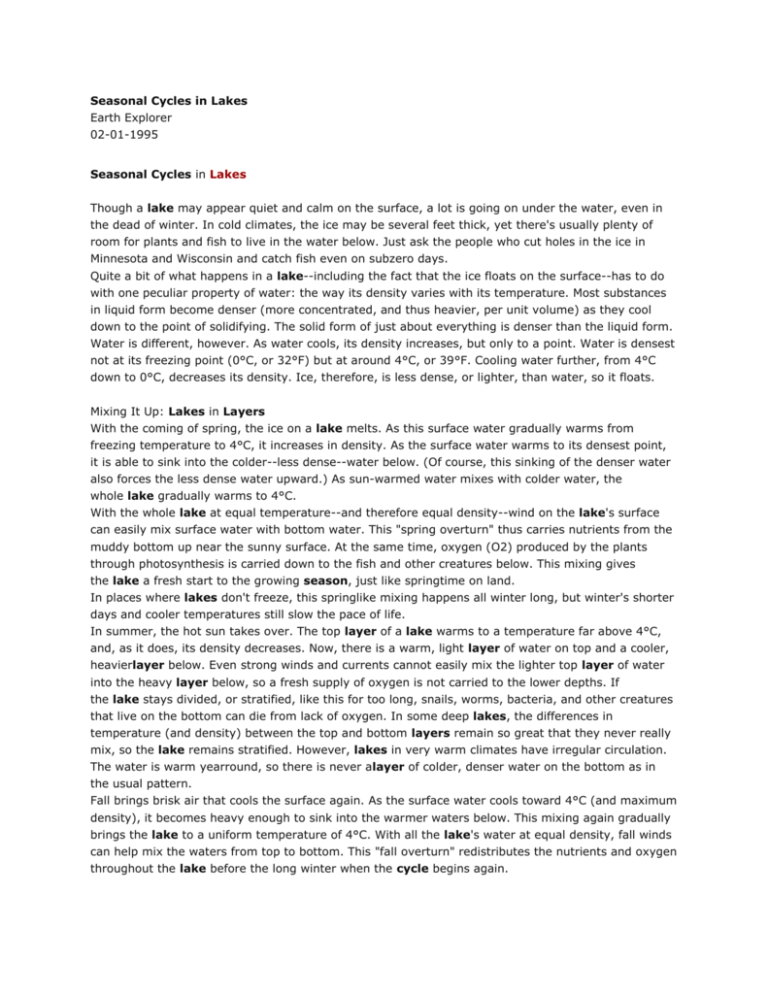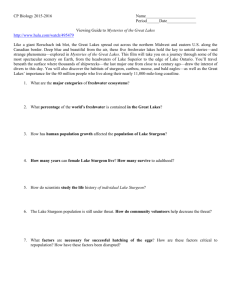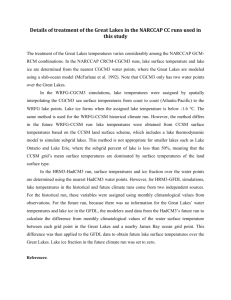
Seasonal Cycles in Lakes
Earth Explorer
02-01-1995
Seasonal Cycles in Lakes
Though a lake may appear quiet and calm on the surface, a lot is going on under the water, even in
the dead of winter. In cold climates, the ice may be several feet thick, yet there's usually plenty of
room for plants and fish to live in the water below. Just ask the people who cut holes in the ice in
Minnesota and Wisconsin and catch fish even on subzero days.
Quite a bit of what happens in a lake--including the fact that the ice floats on the surface--has to do
with one peculiar property of water: the way its density varies with its temperature. Most substances
in liquid form become denser (more concentrated, and thus heavier, per unit volume) as they cool
down to the point of solidifying. The solid form of just about everything is denser than the liquid form.
Water is different, however. As water cools, its density increases, but only to a point. Water is densest
not at its freezing point (0°C, or 32°F) but at around 4°C, or 39°F. Cooling water further, from 4°C
down to 0°C, decreases its density. Ice, therefore, is less dense, or lighter, than water, so it floats.
Mixing It Up: Lakes in Layers
With the coming of spring, the ice on a lake melts. As this surface water gradually warms from
freezing temperature to 4°C, it increases in density. As the surface water warms to its densest point,
it is able to sink into the colder--less dense--water below. (Of course, this sinking of the denser water
also forces the less dense water upward.) As sun-warmed water mixes with colder water, the
whole lake gradually warms to 4°C.
With the whole lake at equal temperature--and therefore equal density--wind on the lake's surface
can easily mix surface water with bottom water. This "spring overturn" thus carries nutrients from the
muddy bottom up near the sunny surface. At the same time, oxygen (O2) produced by the plants
through photosynthesis is carried down to the fish and other creatures below. This mixing gives
the lake a fresh start to the growing season, just like springtime on land.
In places where lakes don't freeze, this springlike mixing happens all winter long, but winter's shorter
days and cooler temperatures still slow the pace of life.
In summer, the hot sun takes over. The top layer of a lake warms to a temperature far above 4°C,
and, as it does, its density decreases. Now, there is a warm, light layer of water on top and a cooler,
heavierlayer below. Even strong winds and currents cannot easily mix the lighter top layer of water
into the heavy layer below, so a fresh supply of oxygen is not carried to the lower depths. If
the lake stays divided, or stratified, like this for too long, snails, worms, bacteria, and other creatures
that live on the bottom can die from lack of oxygen. In some deep lakes, the differences in
temperature (and density) between the top and bottom layers remain so great that they never really
mix, so the lake remains stratified. However, lakes in very warm climates have irregular circulation.
The water is warm yearround, so there is never alayer of colder, denser water on the bottom as in
the usual pattern.
Fall brings brisk air that cools the surface again. As the surface water cools toward 4°C (and maximum
density), it becomes heavy enough to sink into the warmer waters below. This mixing again gradually
brings the lake to a uniform temperature of 4°C. With all the lake's water at equal density, fall winds
can help mix the waters from top to bottom. This "fall overturn" redistributes the nutrients and oxygen
throughout the lake before the long winter when the cycle begins again.
Copyright 1995, Enteractive, Inc., All rights reserved.
Citation for your reference:
"Seasonal Cycles in Lakes." Earth Explorer. 1995. eLibrary. Web. 26 Oct. 2015.
(1995). Seasonal Cycles in Lakes. Earth Explorer. Enteractive. Retrieved from
http://elibrary.bigchalk.com












